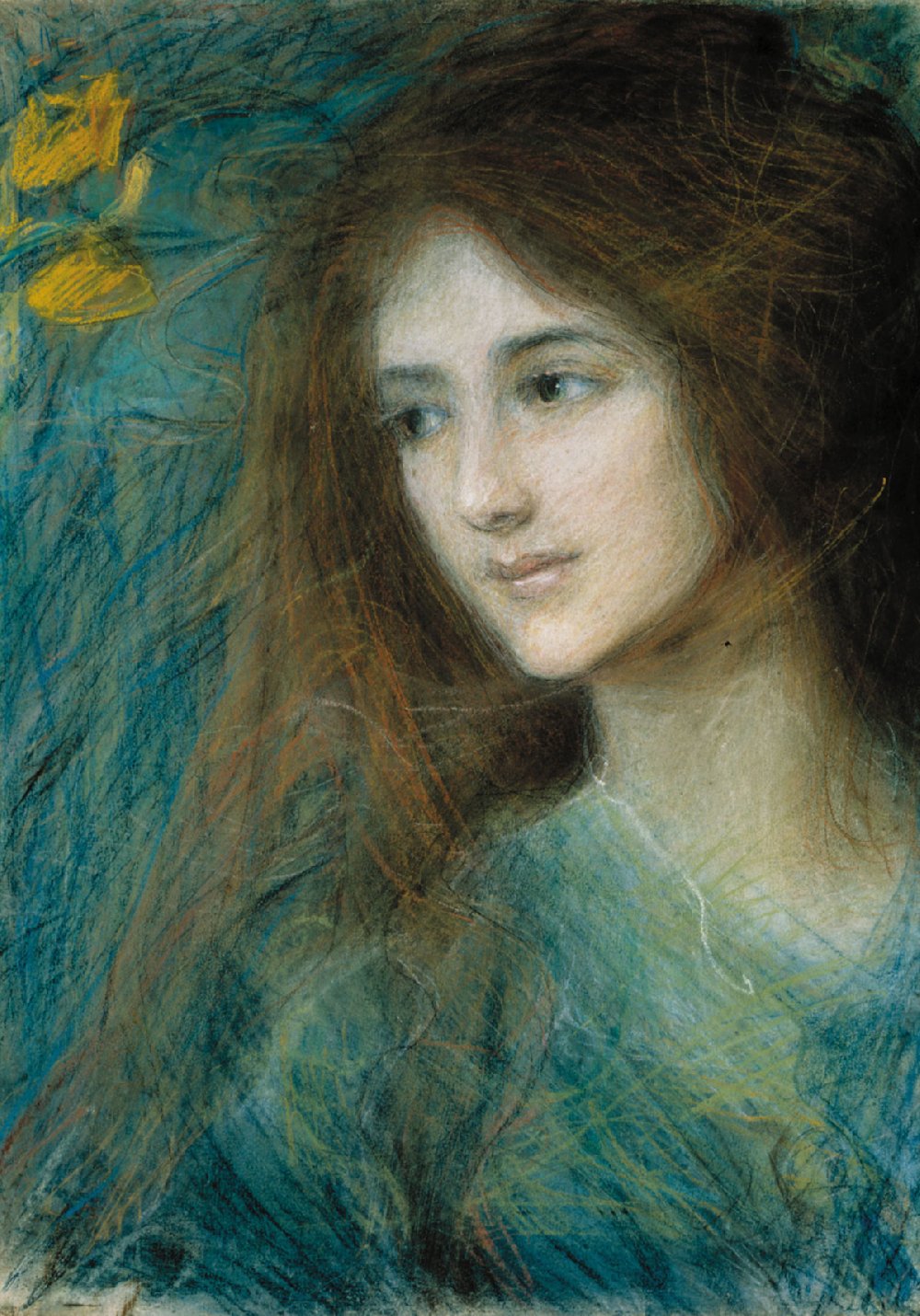Description:
Teodor Axentowicz (1859-1938) gained fame as a portrait painter. This subject of representation idealy fit into his work. Young ladies from higher circles willingly posed for the renowned artist, who was accepted in Parisian salons, and who was equally enthusiastic about accepting these commissions. On the other hand, this allowed Axentowicz to focus on what seemed to interest him the most – attempts to capture the mystery and individuality of the female nature. “Pure femininity is not senses, it is the psychology of the gender […] The dominant accent in female heads and heads is expression. These heads are beautiful, sometimes even very beautiful, as is often the case among real women, but Axentowicz never stops at a beautiful mask. He looks for life contained in the expression.” *.
On August 26th, 1938, one of the last representatives of this generation of painters, who had made the name of Polish painting famous throughout Europe with their talent, passed away in Krakow. This was how the achievements of Teodor Axentowicz were described in the catalogue of the posthumous exhibition at the turn of 1938 and 1939.
We can distinguish three periods in the formation of the painter’s work: the Munich period, 1878-1882, during which he studied under Adolph Wagner and Gyula Benczur; the Paris-London period, spent until 1895, among other things, in the workshop of Émile Carolus-Duran; and the Krakow period, continued until the artist’s death. In Paris and London, Axentowicz became familiar with the works of great masters: Sargent, Velázquez, Hals, Botticelli and Titian, copies of which he made. Just as the Munich period was associated primarily with genre scenes in Axentowicz’s work, during his stay in Paris and contact with great works in London he quickly became a portraitist. Julian Fałat brought the artist to Krakow after 1895. “This painter, more Parisian than many Parisian painters, brought to Krakow a high western European culture and led the then generation of artists with his Europeanness, radiating not only from the master’s works, but also from his art of dealing with people”.
Teodor Axentowicz was able to capture on paper this one characteristic gesture and look of the figure, which gave her an exceptionally distinctive outline. It was often said of him that he was a painter of beautiful Parisians. And indeed his greatest recognition was brought by female portraits. “For the female portrait he created his own pastel technique and subtly muted colour combinations. He often uses gray paper as a backdrop, from which a delicate drawing emerges. He combines the colours with great restraint and discipline in a sophisticated and light way. The seemingly careless pastel lines create rhythmic accents”. *
Description of the painting:
The painting, renowned as one of the artist’s most beautiful pastel portraits, depicts a young red-haired woman, shown up to the chest. Her dark, reddish hair is loose and falls freely on her shoulders. The woman is depicted frontally, her head turned to the right. She looks pensive. Her mood pervades the entire representation. The delicately conveyed subtleness and loveliness of her porcelain-smooth and bright complexion clearly contrasts with the setting, intensifying the impression of its unreality.
The woman is dressed in a turquoise dress with a muslin covering her décolletage. The colour of the dress is duplicated and, thus, reinforced in the shade and texture of the undefined background of the representation. Both elements are outlined with distinct, sweeping lines. A strong, colour-wise completing accent of the composition are the two yellow flowers that appear at the height of the model’s head, symbols of femininity, beauty and delicacy (Cf. “Spring”, 1900 T. Axentowicz).
The figure of the red-haired woman often appears in the works of Teodor Axentowicz. She is identified as Ata (otherwise Ama), or Anna Teresa Zakrzewska, one of the sisters known in Krakow circles for her charming beauty. Such an identification of the figure is allowed by the analysis of similar portrait works of the painter from this period depicting Ata, as well as the time of creation of the work, pointing unambiguously to the period of the artist’s Krakow creativity and this environment.
Similar colors of the undefined background and roughly treated dress of the Redhead direct almost all attention to the delicate face of the young girl surrounded by a “storm” of red hair. The special lyricism emanating from this beautiful portrait may indicate that this may be the image of Axentowicz’s wife Iza Giełgudówna, met in the 90s in London.
This earliest work from Edward A. Raczyński’s collection, an Axentowicz portrait, is among the best of the artist’s works. Painted in Kraków after Axentowicz returned from his foreign travels and assumed the chair of painting at the Kraków Academy, it displays his extraordinary ability to work with pastels, which he often used to create subtle and sophisticated images of women.
Axentowicz became interested in portraiture after studying in Charles Carolus-Duran’s studio in Paris, with breaks, from 1882-1895. His ability to study the works of old masters at the Louvre and London galleries resulted in Axentowicz forming his own style, often similar to the works of James McNeill Whistler, John S. Sargent, and Giovanni Boldini.
Besides the popular portrait art of Axentowicz, since his studies at the Munich Academy under Gabriel von Hackl, Alexander von Wagner and Gyula Benczur, he also practiced historical and genre painting. The experiences gained at this university, as well as the encounter with French Impressionism, determined the realistic-snapshot treatment of the scenes from the life of the Hutsuls already painted in Krakow.


